Game Fish
Native and hatchery rainbow trout, native and hatchery kokanee salmon, walleye, smallmouth bass, largemouth bass, yellow perch, lake whitefish, mountain whitefish, brown trout, brook trout, burbot, sturgeon, cutthroat trout, bull trout, black crappie, pumpkinseed, brown bullhead, yellow bullhead, channel catfish.
Non-Game Fish
Native to the Upper Columbia include northern pike minnow, largescale sucker, longnose sucker, bridgelip sucker, redside shiner, longnose dace, chiselmouth, peamouth, speckled dace, sculpin species; non-natives include carp and tench.
Rainbow Trout
Since artificial production began rainbow trout harvest has grown exponentially. Currently 20,000 rainbow trout are floy tagged to monitor movements and growth (10,000 Spokane stock triploids and 10,000 redband trout). The majority of rainbow trout harvested are hatchery reared, usually distinguishable through worn pectoral fins and bent dorsal fin rays. Two stocks of rainbow trout are used in Lake Roosevelt; the Spokane stock (100% triploid) and the Phalon Lake stock, which are interior redband rainbow trout native to the Kettle River system. The primary reason for triploiding the rainbow trout is to reduce interactions with native trout. The non-native Spokane stock rainbows have the potential to breed with the native fish and reduce their genetic integrity. Tagging studies revealed the triploid trout released in Lake Roosevelt did not experience excessive growth rates, as seen in other waters, and were harvested at the same rates as non-sterile rainbow trout. Therefore to protect native fish, the program switched to 100% sterile Spokane stock rainbow trout in 2006.
Rainbow trout fishing is good throughout the reservoir during all times of the year. Water temperature dictates the depths rainbow trout will be found. They vary from the surface during cooler months to 100 feet during the summer months. Both bank and boat anglers are highly successful.
Kokanee Salmon
Artificial production of kokanee salmon has increased harvest numbers. The put-and-take fishery is best between July and September between Hunters and the Whitestone Rock area (primarily near the Seven Bays area). Two stocks are utilized: Lake Whatcom (Bellingham, WA) and Meadow Creek (British Columbia). Meadow Creek kokanee are preferred because they are native to the Upper Columbia system and lessen potential impacts with naturally occurring stocks in and downstream of Lake Roosevelt.
Wild kokanee fishing is generally good year around, with the exception of early August - September when adult kokanee tend to spawn. Native kokanee are usually harvested in the lower reservoir (from Whitestone Rock down to the dam).
All hatchery kokanee are adipose fin clipped to distinguish them from wild kokanee. Hatchery kokanee tend to average between 12 and 16 inches, and native kokanee average between 15 and 21 inches. The state record was captured out of Lake Roosevelt on June 16th, 2003 (25.4 inches and 5.9 lbs. or 605 mm and 2,687 grams).
Walleye
Illegally stocked in the 1950's, walleye populations grew rapidly preying on the large native prey source. Walleye are successful in Lake Roosevelt because they spawn in the spring when the reservoir is refilling. Concerns about a population crash in the late 1980's prompted the large spawning run on the Spokane River to be closed (May to June) to protect large spawning fish. The Spokane River is still closed to walleye fishing during the spawning time. Harvest estimates averaged 127,053 walleye per year since 1990. Walleye fishing is best during the spring and early summer months in the Spokane Arm and north to Northport. A heavy concentration of walleye migrate out of the Spokane River after spawning, north to the Colville River and near Singers Bay (near Kettle Falls boat launch) where they stay during the summer months. Walleye can make long migrations, British Columbia tagged fish have been collected in the Spokane River and vice versa. Walleye average 16 to 20 inches at harvest, walleye up to 18 pounds have been captured.
Smallmouth Bass
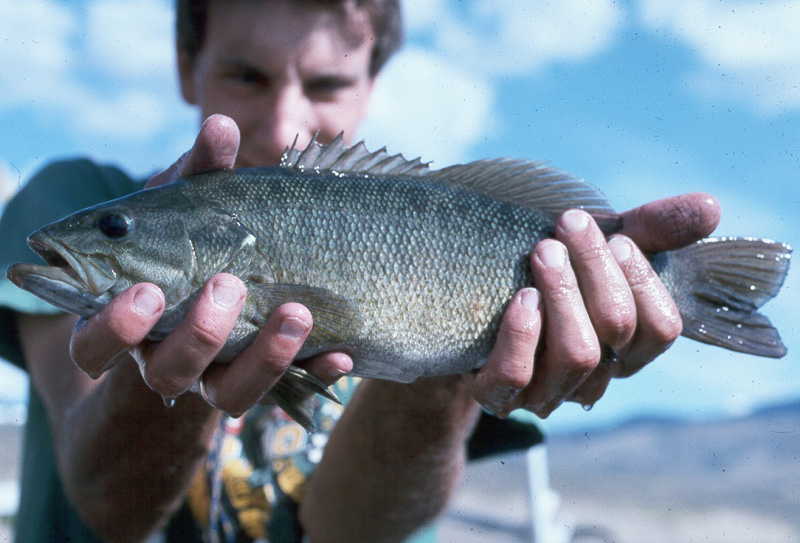
During the past few years, smallmouth bass fishing has increased dramatically. Summer months are the best smallmouth bass fishing, especially for 6 to 8 inch fish (great for the kids). Drop your line near any creek mouth in the Spokane River or below and you are sure to get a bite. The larger fish tend to be captured in the lower reservoir along the steep cliffs.
Sturgeon

Fishing for sturgeon in Lake Roosevelt is currently closed due to the low number of adults and the apparent lack of juvenile recruitment. The Upper Columbia White Sturgeon Initiative is a cooperative effort between Canada and the United States to protect and save this prehistoric fish.
Bull Trout
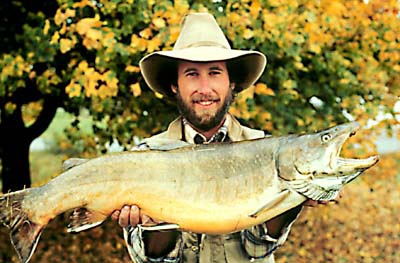
Rarely captured by anglers, but a few bull trout are present in the reservoir. These fish are presumably wash downs from the Pend Oreille or Canadian systems. Bull trout are listed as threatened under the Endangered Species Act and must be released if captured.
Other Game Fish
Lesser fisheries exist for burbot, Chinook salmon, brown trout, brook trout, lake whitefish yellow perch, largemouth bass, yellow perch, black crappie, and pumpkinseed.
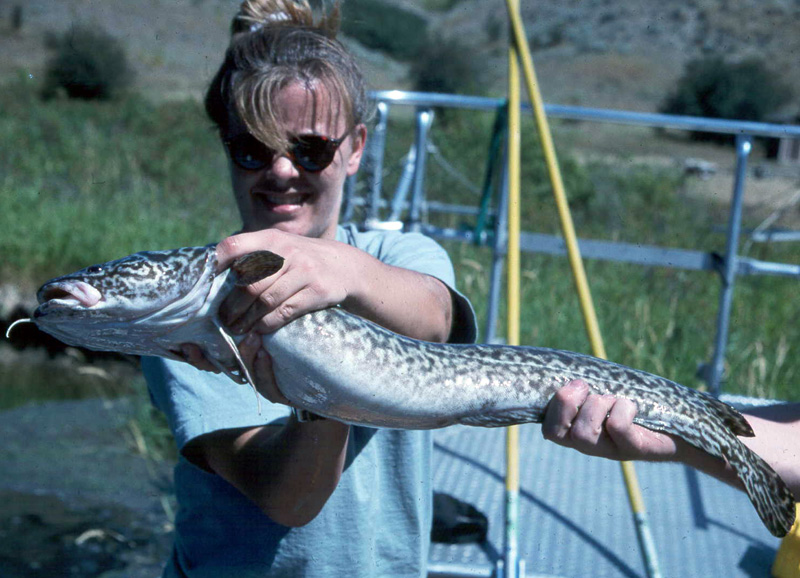 Burbot, native to the Columbia River system, are popular to fish for during the winter months near the Colville River. They are a prehistoric fish with a serpentine swimming style. They have a single soft barbel protruding from their chin which is used for sensing prey.
Burbot, native to the Columbia River system, are popular to fish for during the winter months near the Colville River. They are a prehistoric fish with a serpentine swimming style. They have a single soft barbel protruding from their chin which is used for sensing prey.
 Chinook salmon are not stocked into Lake Roosevelt, but wash downs from Coeur d' Alene Lake have been collected in the reservoir. These fish are planted in Coeur d'Alene Lake as a management tool to control kokanee populations. Chinook as large as 20 pounds have been collected in Lake Roosevelt.
Chinook salmon are not stocked into Lake Roosevelt, but wash downs from Coeur d' Alene Lake have been collected in the reservoir. These fish are planted in Coeur d'Alene Lake as a management tool to control kokanee populations. Chinook as large as 20 pounds have been collected in Lake Roosevelt.
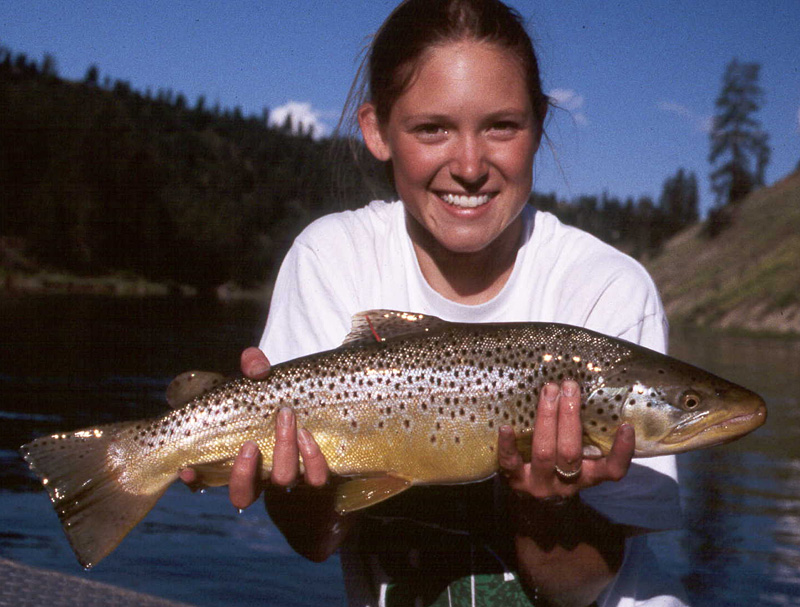 Brown trout and brook trout are usually captured near tributaries where smaller fish tend to hide from predators. Densities are low, but a few large fish can be captured.
Brown trout and brook trout are usually captured near tributaries where smaller fish tend to hide from predators. Densities are low, but a few large fish can be captured.
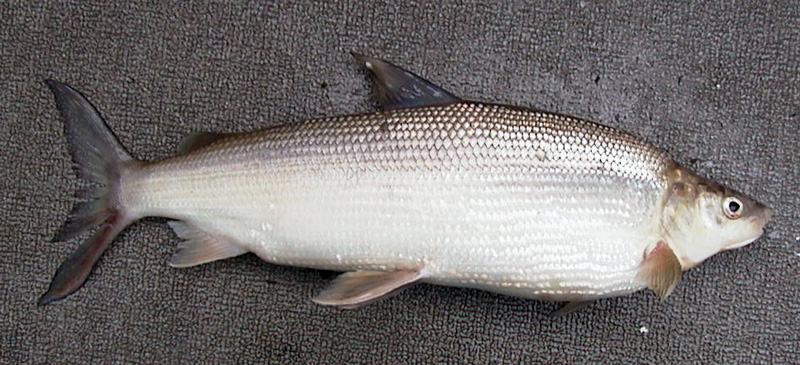 Lake whitefish are an underutilized fishery in Lake Roosevelt, as well as in Banks Lake. Lake whitefish are non-native planktivores found in deeper waters. Their densities are high near the Hawk Creek area and south to the dam.
Lake whitefish are an underutilized fishery in Lake Roosevelt, as well as in Banks Lake. Lake whitefish are non-native planktivores found in deeper waters. Their densities are high near the Hawk Creek area and south to the dam.
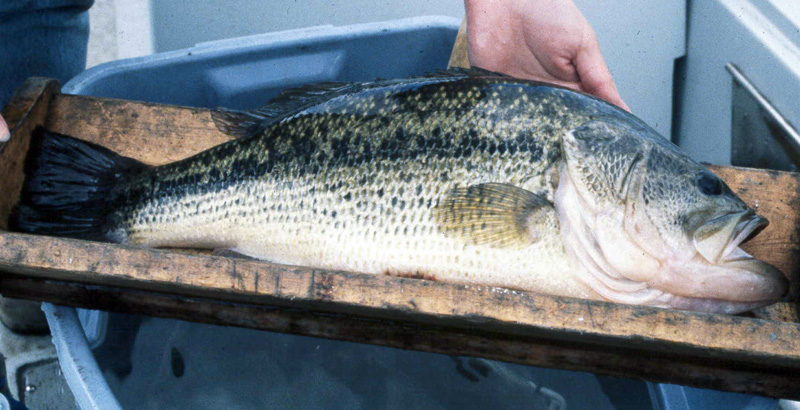 Largemouth bass are usually captured in the Colville River, some areas of the Spokane Arm, or San Poil River where more aquatic vegetation exists. Densities are low, but a few large fish have been captured.
Largemouth bass are usually captured in the Colville River, some areas of the Spokane Arm, or San Poil River where more aquatic vegetation exists. Densities are low, but a few large fish have been captured.
Yellow perch, black crappie, and pumpkinseed are found in embayments among the limited shoreline habitat. Large numbers of juvenile fish exists with few large adults presumably due to the lack of suitable habitat.






















